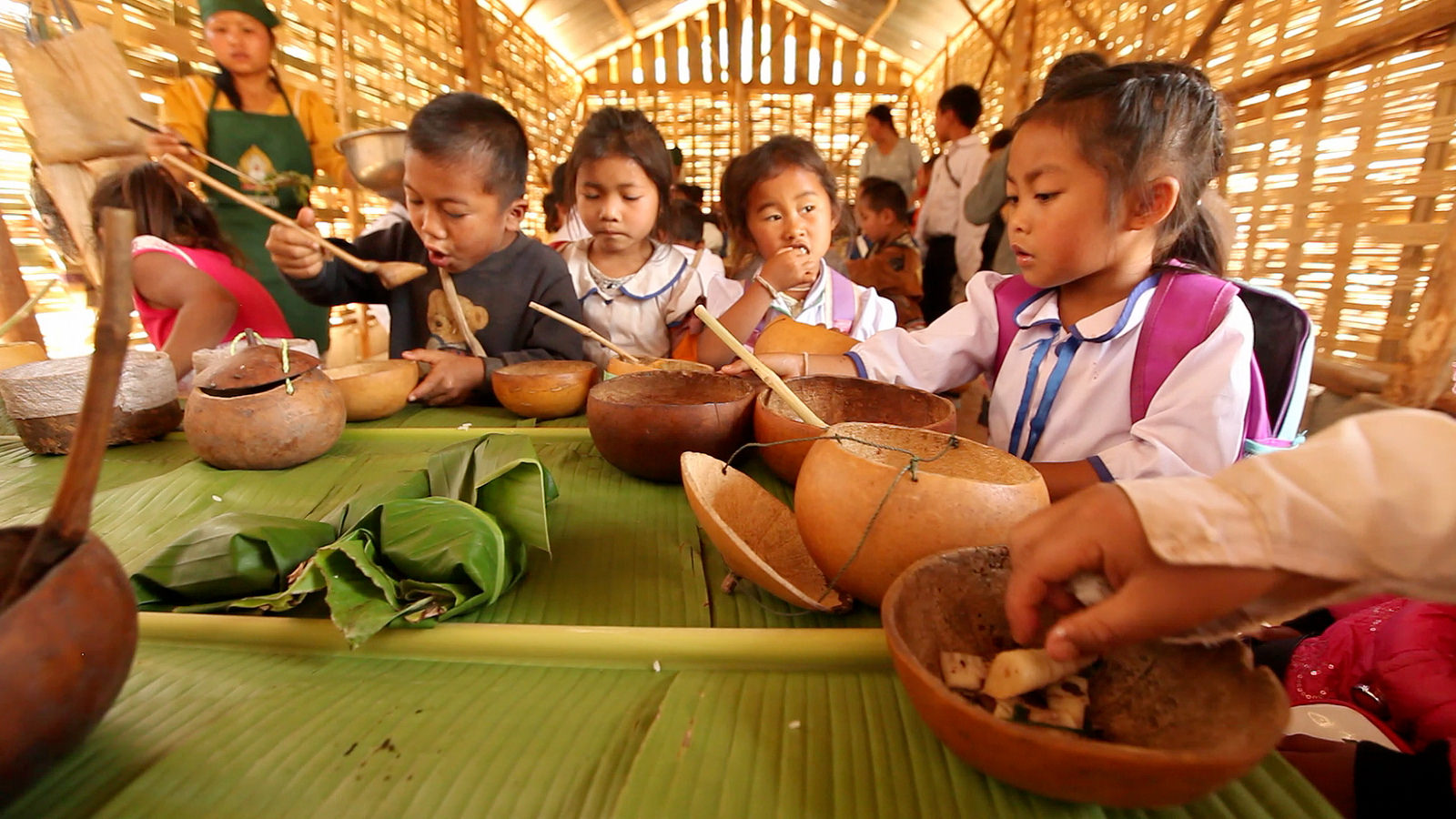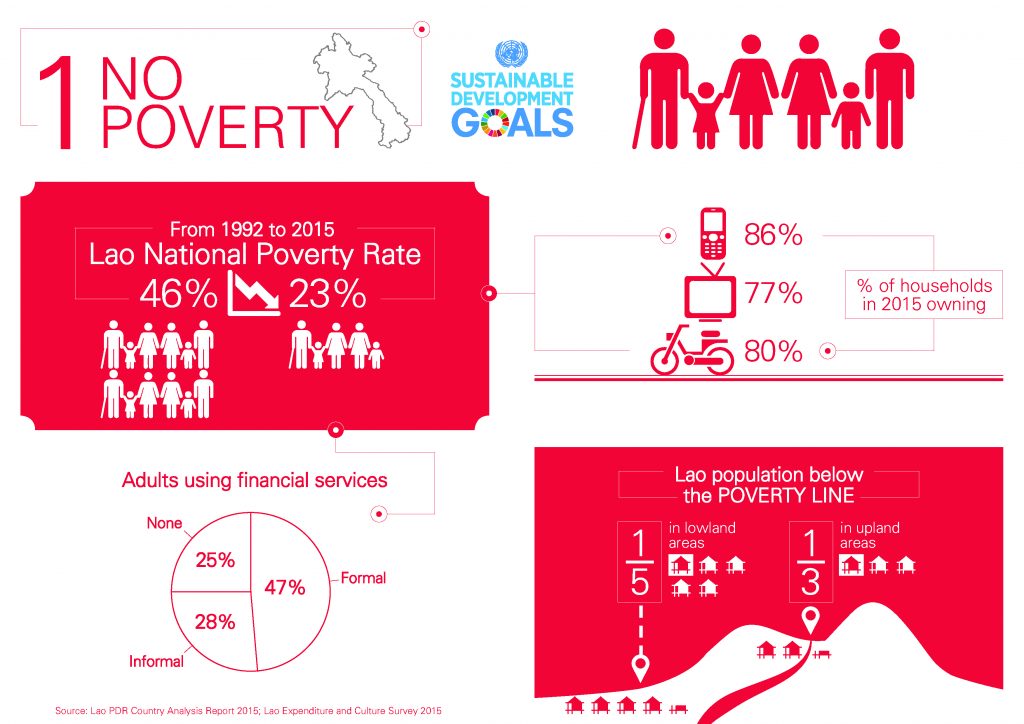Sustainable Development Goals 1 (SDG 1) – ‘No Poverty’ aims to eradicate all forms of poverty globally. The goal also focuses on ensuring social protection, increasing access to basic services and supporting the resilience to climate-related disasters and other economic, social and environmental shocks for the poor and vulnerable.1 SDG 1 includes 7 targets, with 12 measuring indicators in total. Targets 1.1-1.5 include poverty eradication, social protection, access to services, and disaster resilience, and targets 1.A-1.B are subject to resource mobilization and policy frameworks for poverty elimination actions.2

A primary school in Lao PDR, a lunch at school. Photo by: GPE/Stephan Bachenheimer, January 17, 2015. License: CC BY-NC-ND 2.0.
From the Millennium Development Goals to SDG 1
Millennium Development Goals (MDGs) are global development goals which were adopted in 2000, and set to be achieved by 2015, as a guideline for governments and development partners. The MDGs included 8 measurable targets, with the aim to eradicate extreme poverty and improve standards of living around the world. The MDGs focus on development in the fields of education, gender equality, health, environment and global partnership. By the end of MDGs target implementation in 2015, Sustainable Development Goals (SDGs) have been developed to build on the successes and challenges of MDGs. By expanding the MDGs that largely focused on social development, SDGs span to all dimensions of sustainable development, economic, social and environmental. SDGs are current universal development goals that can be applied to all countries discarding their levels of development, towards to sustainable development.3
SDG 1 is relevant to MDG Goal#1, ‘Eradicate extreme poverty and hunger’, especially the Target 1.A – Halve, between 1990 and 2015, the proportion of people whose income is below the poverty line. In regard to MDG Target 1A, Lao PDR had achieved the target by halving the poverty rate from 46% in 1992/93 to 23% by 2012/13. Household welfare regarding the asset ownership, housing conditions and basic services accessibility has relatively improved. The poor has been less poor throughout the country on average, with a steady decrease in the poverty gap and severity.4
Despite the achievements, disparities in poverty are still considerable among different locations and groups. The poverty headcount rate is 2.9 times higher in rural areas, compared to the urban areas. Remote upland regions are generally poorer than the lowland. Of total 17 provinces in Laos, while poverty reduction can be observed in the other provinces, there had been an increase in poverty trends in Bokeo, Champasack and Saravane between 2002/03 and 2012/13. A poverty gap among ethnic groups also exists. While Lao-Tai and Chine-Tibetan ethno-linguistic groups have seen a significant improvement in poverty, Mon-Khmer and Hmong-Lu Mien groups are still struggling. In addition, the consumption disparities between the poorest and richest quintiles had been widened from 1992/93 to 2012/13. The consumption of the richest was 6.4 times that of the poorest in 2012/13.5
Besides, a large proportion of the population, especially farmers, who live just over the poverty line are vulnerable to fall into poverty due to climate-related shocks and other catastrophes.6
Map created by: ODL. Data source: 1, 2, 3. Map layer: 1. Scripts adapted from 1, 2, 3. License: CC BY-SA 4.0.
To address these challenges as well as to end poverty, the government of Lao PDR has localized SDG 1 to the local context, which can be grouped into 4 key outcome areas: (i) improved access to resources, services and markets for the poor (Targets 1.1, 1.2 & 1.4); (ii) reduced inequalities through targeted interventions, policies and laws (Targets 1.1 & 1.2); (iii) substantial coverage of the poor by social protection systems and measures (Target 1.3); and (iv) increased resilience of vulnerable groups and reduced vulnerability to climate-related extreme events and calamities (Target 1.5).7
Localization of SDG 1 in Laos
The localization of SDGs has been mainly made by incorporating the goals into the National Socio-economic Development Plan (NSEDP), where certain targets and indicators in the NSEDP monitoring and evaluation framework are adapted to the SDGs’ to support the implementation and monitoring of both.8 As for SDG 1, since the government prioritizes poverty reduction on the national agenda, including the national Vision 2030 and Ten-year Socio-Economic Development Strategy (2016-2025),9 its indicators have been integrated with the overall goal in the 8th National Socio-economic Development Plan 2016-2020, specifically Outcome 2, Output 1 – Improved living standards through poverty reduction and Output 5 – Enhanced Social Protection/Welfare.10
Localized SDG 1 is particularly important for Lao PDR in terms of graduating from a Least Developed Country (LDC) status. According to the latest UN update, Lao PDR is eligible for LDC graduation in 2024, providing that it can overcome the current key challenges in inequalities (SDG 1 Targets 1.1 – 1.4) and disaster vulnerability (SDG 1 Target 1.5).11
Implementation of SDG 1 in Laos
Incorporated into the NSEDP, SDG1 have been implemented at policy, sectoral and/or project levels. For example:
- The Lao National Chamber of Commerce and Industry established a Branding Lao Promotion and Development Facility, to help local producers get better returns for their produce by identifying potential profitable Lao products to be exported to international markets.12
- Lao Road Sector Project 2 (LRSP2) is an infrastructural development project in the north and central provinces, aimed at connecting rural areas, when considered the climate resilient characteristics and the benefits of marginalized areas and ethnic groups.13
- The government has set up a guideline, known as ‘the Guideline on Ethnic Group Consultation’, for ethnic group engagement, especially marginalized groups, in all relevant development projects to ensure the benefits and inform on potential impacts to their communities and livelihoods.14
- The Bank of the Lao PDR had established regulations and guidelines for microfinance programmes under the support of multilateral development partners, to provide access to finance and financial services to rural communities and the poor, contributing to overall reduction in poverty.15

Lao PDR SDG 1: No poverty. Visualization by: United Nations Lao PDR.
Social protection for the poor and vulnerable and poverty disparities are currently among the most lagging areas in SDG 1 implementation and lack of proper monitoring.16 To this end, the government of Lao PDR has formulated the strategies for the path towards SDG 1, as follows:17
- Targeting the poor in planning, budgeting, and programme delivery: which involves applying a coordinated and convergent approach, by targeting the poor in remote and urban areas.
- Prioritizing interventions based on evidence: which focuses on the improvement in the key areas evident to the poverty such as access, education, employment/livelihood and the price of agricultural produce.
- Strengthening social protection systems to cover vulnerable groups: by improving the scope and ensure the access to social protection schemes and health coverage, particularly for the poor and vulnerable.
- Increasing efforts to tap domestic capital through public-private partnerships: by engaging the participation of and encouraging the funding from private sectors into local development.
Monitoring SDG 1 in Laos
Lao PDR has two approaches to measure poverty prevalence (Targets 1.1, 1.2 & 1.4). The first is using the Lao Expenditure and Consumption Survey (LECS), a five-year household survey on expenditure and consumption, with international poverty indicators, by the Lao Statistics Bureau (LSB). The second is the administrative data on household income and access to basic services (clean water, health facilities, and schools) collected yearly by the National Committee for Rural Development and Poverty Eradication (NCRDPE). SDG 1 Target 1.4 on access to basic services and economic resources can be thematically tracked accordingly to related indicators of SDG 3 on health, SDG 4 on education, SDG 6 on water and sanitation SDG 7 on electricity, and SDG 8 on access to financial services and institution. Meanwhile, data on land tenure might be retrieved from Ministry of Natural Resources and Environment (MoNRE).18 19
On the other hand, monitoring of Target 1.3 on social protection and Target 1.5 on climate resilience of the poor and vulnerable still face a challenge. Social protection needs improvement, both in the implementation and progress monitoring. The majority of households are working in the informal sector such as agriculture. They are not protected by any existing social protection schemes and health insurance which are mostly for formal worker. This also makes it difficult in terms of measurement. The government is addressing this challenge with support from development partners. Meanwhile, for resilience indicators, the current tracking system only focuses on the impacts of disasters and the availability of strategies for disaster risk reduction (DRR). Because disasters are country-specific, the government needs to develop its own strategies for the monitoring.20
In order to strengthen the implementation, monitoring and review of the SDGs, Lao PDR had also developed its first National Voluntary Report (VNR) in 2018 in consultation with ministries, government agencies and local authorities, as well as development partners, civil society organisations and private sectors. The report was presented at the high level political forum (HLPF) 2018, highlighting the success, challenges and future strategies towards the goals and the 2030 Agenda for Sustainable Development.21
Related to this page
References
- 1. United Nations. 2018. “Goal 1: End poverty in all its forms everywhere.” Accessed October 2018.
- 2. United Nations. 2018. “Sustainable Development Goal 1: End poverty in all its forms everywhere.” Accessed October 2018.
- 3. UN in the Lao PDR. 2017. “From Millennium Development Goals to Sustainable Development Goals: Laying the base for 2030.” Accessed October 2018.
- 4. The United Nations in the Lao PDR. 2015. “The Millennium Development Goals and Lessons Learnt for the Post-2015 Period: A Summary Review.” Accessed October 2018.
- 5. UN in the Lao PDR. 2017. “From Millennium Development Goals to Sustainable Development Goals: Laying the base for 2030.” Accessed October 2018.
- 6. The United Nations in the Lao PDR. 2015. “The Millennium Development Goals and Lessons Learnt for the Post-2015 Period: A Summary Review.” Accessed October 2018.
- 7. The United Nations in Lao PDR. 2015. “Discussion Paper: The Sustainable Development Goals in the context of the Lao People’s Democratic Republic.” Accessed October 2018.
- 8. The United Nations in Lao PDR. 2017. “Tracking progress towards National Development Goals and Sustainable Development Goals.” Accessed October 2018.
- 9. Ministry of Planning and Investment. 2016. “Vision 2030 and Ten-year Socio-Economic Development Strategy (2016-2025).” Accessed October 2018.
- 10. Ministry of Planning and Investment. 2016. “8th Five-Year National Socio-Economic Development Plan (2016-2020).” Accessed October 2018.
- 11. UNDP. 2018. “As Lao PDR prepares for LDC Graduation, inequality has to be overcome.” Accessed October 2018.
- 12. UNDP. 2017. “Brand Lao-for better livelihoods.” Accessed October 2018.
- 13. Nordic Development Fund. 2016. “Lao PDR Road Sector Project II [NDF C92/C93].” Accessed October 2018.
- 14. Department of Planning, Investment and Finance, Ministry of Agriculture and Forestry. 46. “Ethnic Groups Engagement Framework.” Agriculture Commercialization Project. Accessed October 2018.
- 15. Lao Micro Finance Association. 2018. “Microfinance in Laos.” Accessed November 2018.
- 16. United Nations ESCAP. 2018. “Statistical Yearbook for Asia and the Pacific 2017: Lao PDR SDG datasheet.” Accessed November 2018.
- 17. Government of the Lao PDR. 2018. “Lao PDR Voluntary National Review on the Implementation of the 2030 Agenda for Sustainable Development.” Accessed November 2018.
- 18. Ibid.
- 19. UN in the Lao PDR. 2017. “From Millennium Development Goals to Sustainable Development Goals: Laying the base for 2030.” Accessed October 2018.
- 20. Ibid.
- 21. Government of the Lao PDR. 2018. “Lao PDR Voluntary National Review on the Implementation of the 2030 Agenda for Sustainable Development.” Accessed November 2018.

